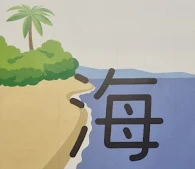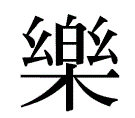★ The traditional Chinese characters is different from the current Chinese character used in the China. The current Chinese language has a simpler and easier to use structure than in the past. (There are countries that used a mixture of the traditional Chinese language, such as Taiwan, Hong Kong, and Korea.)
#There are some examples.
(Traditional Chinese characters → The current Chinese character)
貝 → 贝
語 → 语
鳥 → 鸟
龜 → 龟
龍 → 龙
(※ In some cases, Chinese characters that are simple or need not be reduced are used as they are in traditionla Chinese characters,)
六書(Lyukseo)
六 is mean 'Six'
書 is mean 'Letter(Type)'
So, 'Lyuk Seo' is mean that The principle of the formation of Traditional Chinese chatacters.
- 象形(Sanghyeong)
It's letter that has a specific shape or is modeled after an object.
Some EX)
The meaning is a 'Fire'
The meaning is a 'Turtle'
- 指事(Jisa)
It's a letter that represents an abstract meaning that can't be seen with the eyes.
Some EX)
The meaning is a 'One'
The meaning is a 'Root' or 'Basis'
- 會意(Hoeui)
It's a letter with a new meaning derived from the meaning of each letter by combining two or more letters.
Some EX)
The meaning is a 'Forest'
The meaning is a 'I luv you' or 'I like something'
(※ '女' is mean 'Woman', '子' is mean 'Man')
- 形聲(Hyeongseong)
It's a letter created by combining Chinese letter related to meaning and Chinese letter related to sound(pronunciation).
Some EX)
The meaning is a 'Sea'
(※ '氵= 水' is mean 'Water' and '每' only brought the sound 'Mae')
(★ When Chinese letters make, the sound may be the same or similar, and of course it may be completely different.)
(The Chinese letter in the above example brings the sound 'Mae', but it is pronounced 'Hae'.)
The meaning is a 'Castle'
(※ '土' is mean 'Soil, '成' is mean 'Make, Form')
('成' is pronounced 'Seong', also '城' is pronounced 'Seong'.)
- 轉注(Jeonju)
Even now, '轉注' can't define exactly what it is. (Some letters have multiple sounds and meanings.)
Some EX)
It has meanings sucah as 'Music', 'Musical instruments', 'Pleasure'.Also it has sounds 'Rak', 'Yo'.
- 假借(Gacha)
It's used as an onomatopoeia and mimic words that have no meaning in their letters. Sometimes it is expressed only the form of letters without meaning.
(Sometimes it is also used in foreign languages of other countries.)
Some EX)
佛蘭西
This means 'France'.
亞細亞
This means 'Asia'.
弗
This means 'Dollar'.
History of Traditional Chinese characters(origin)
(※ '文字' is mean 'Letter'.)
It's the oldest 'Systematic' character discoverd in East Asia, dating from 1200 B.C, and a direct ancestor of the Chinese characters. The method and date of the ritual(Holy ritual) were recorded on the turtle shell.
- 鐘鼎文字=金文(Jongjeongmunja=Geummun)
(※ '金' and '鐘' mean 'Iron'.)
(※ '鼎' mean traditional caldron made of cast iron in the East Asia, looks like iron big pot.)
Jongjeongmunja's letters were engraved on ritual iron containers, and they wewe mainly used during the Bronze Age in the East Asia.
It's not practical, but it's an artistic font.
- 隸書(Yeseo)
It's the next Chinese character typeface by Jeonseo used in the Qin Dtnasty.
Yeseo made it easier to understand by simply transforming the complexity of Jeonseo.
- 楷書(Haeseo)
(You can think of it as a little bit more improvement on Yeseo.)
- 行書(Hangseo)
Also, It's practical and has a lot of influence on simplified Chinese characters(current Chinese).
(※ '行(Hang)' means to go ground.)
- 草書(Choseo : Cursive script)
It is a character that influenced Japanese language and is now mainly used in the realm of works of art. (There are cases where the writer doesn't know what it means even after writing it.)


















.jpg)



![[Ggupdang Main Store(Sinsa)] A Famous Korean Restaurant in Sinsa, Seoul (Michelin Guide Bib Gourmand in South Korea 2024)](https://blogger.googleusercontent.com/img/b/R29vZ2xl/AVvXsEgMBGEf6AVsJHyxpkrtlYO3kprXdX-wvGllPBlG9cUAGpn4hEiPTQ8SiYBo8LgKFgnvVkMOrhxoxEnCBqvh4ORHVlPX1Px7qdqAe3uuRPIo0fuL0cyGXQwsWiNerZuLI9VkcthPMpb-UaD-e70haBV7FhYEFKZULogfCz3wlya6GOj4dvsD3fGZXt3xcIw/w72-h72-p-k-no-nu/SE-9190fed7-e1b5-4146-8d16-c18a3bbf9f9c.jpg)
![[Oreno Ramen Main Store(Hapjeong)] A Famous Korean Restaurant in Hapjeong, Seoul (Michelin Guide Bib Gourmand in South Korea 2024)](https://blogger.googleusercontent.com/img/b/R29vZ2xl/AVvXsEhJ3MB_0q5bvF-Ze01BxkClOFze3ARLRFs4blkzjA5mFPJZg9Z-8lRTSXdzMFotnIQiPgrNpWTOs5g66GoliuRNP5s_orWEAIEExmrtbriYazzSG56HMbOul8BNc4tgfbyj7lKXhvO18mkPnjw2UeKlGwZ88eFwS_UB_DoC7DmQQrj1yG9_FFfrl5qwATM/w72-h72-p-k-no-nu/SE-5b245596-56df-40e4-bd94-c27720387b40.jpg)

0 Comments